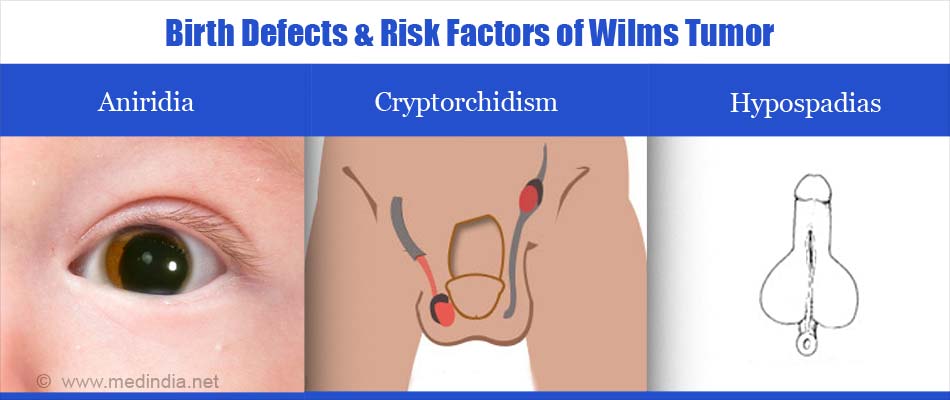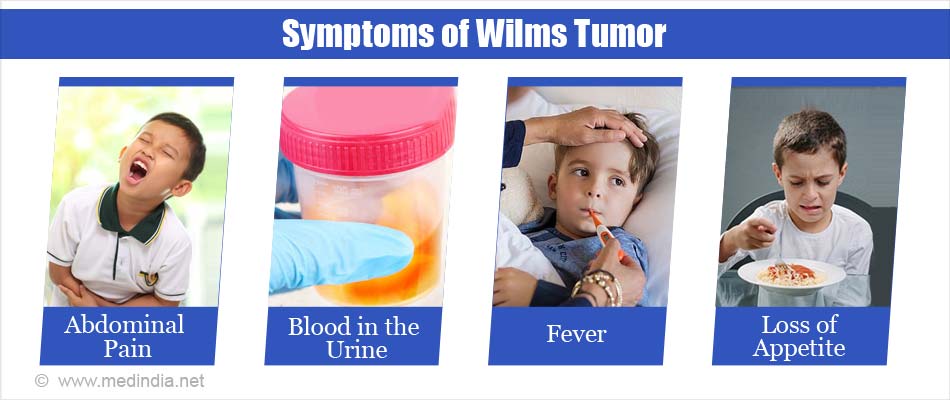What is Wilms Tumor?
Wilms tumor (WT) is the most common cancerous pediatric kidney tumor, generally seen in children of less than five years of age. It is also called as nephroblastoma and is named after Max Wilms, a German surgeon and pathologist, who was one of the first to describe this disease in 1899. Wilms tumor generally affects the kidney, but sometimes extra renal locations have been reported, such as the testis, retroperitoneum, inguinal canal, the sacrococcygeal region, uterus, and mediastinum.
Risk Factors of Wilms Tumor
Age- This tumor is generally common in young children, with the average age being about 3 to 4 years.
Race-The African-American children are at somewhat higher risk of getting Wilms tumor than whites and the risk is lowest among Asian-American children.
Gender- Girls have a rather higher risk of Wilms tumor than boys.
Family history- About 1-2% of children with Wilms tumors have one or more relatives but not the parents with the same kidney cancer and these children are somewhat more likely to have tumors in both kidneys.
Birth defects /Genetic syndromes - About 1 child in 10 with Wilms tumor also has certain birth defects or syndromes. Wilms tumor is more common in children with congenital malformations and certain birth defects:
Aniridia- It is characterized by complete or partial lack of the iris of the eyes.
Hemihypertrophy- Children with this defect have an oversized arm and/or leg on one side of the body.
Cryptorchidism- It is the failure of the testicles to descend into the scrotum in boys.
Hypospadias- This is a defect in boys where the urinary opening is on the underside of the penis.

What are the Types of Wilms Tumor?
Wilms tumor usually affects only one kidney (unilateral), but sometimes it affects both the kidneys (bilateral) in about 1 out of every 20 children diagnosed with Wilms tumor. Wilms tumors are classified into 2 major types based on their appearance under the microscope:
Favorable: The tumor cells in this type don’t look quite normal, but they are not of high malignant type or anaplastic. Majority of Wilms tumors have favorable histology and the chances of curing children with these tumors are very high.
Unfavorable (Anaplastic): The appearance of the tumor cells varies greatly, with large and irregularly shaped nuclei and is called as anaplasia. The treatment of Wilms tumor becomes inversely proportional to the level of anaplasia the tumor exhibits.
What are the Causes of Wilms Tumor?
The reason why some children get Wilms tumor is not known, however researchers have made progress in determining how the Wilms tumor can arise during the course of normal development of kidneys.
Genetic Mutations leading to Wilms tumor - Mutations in some genes increase the chances of getting a Wilms tumor. For example, mutations in WT1 or WT2 genes, which are tumor suppressor genes found on chromosome 11 give rise to a small number of Wilms tumors.
In about 30 % of Wilms tumors, there is inactivation of WTX, a tumor suppressor gene present on the X chromosome. Further, CTNNB1, the gene encoding the proto-oncogene beta-catenin, is sometimes altered in Wilms tumor cells, but it is not clear exactly what causes these genes to be altered. Also, most cases do not have mutations in any of these genes. Some gene changes can be inherited, but most Wilms tumors are not the result of known inherited syndromes. Most Wilms tumors have no definite cause, but there are some factors that affect the risk.
Syndromes linked to Wilms tumor include:
WAGR syndrome: WAGR is a rare genetic syndrome and predisposes the affected children to -
- Wilms tumor
- Aniridia
- Genitourinary tract abnormalities (defects of the kidneys, urinary tract, penis, clitoris, scrotum, ovaries or testicles)
- Retardation
Children suffering from this syndrome lack the part of chromosome 11 having the WT1 gene and often have tumors in both kidneys.
Denys-Drash syndrome and Frasier syndrome: These syndromes are very rare and also been linked to mutations in the WT1 gene.
In Denys-Drash syndrome, when the child is young, the kidneys become diseased, the Wilms tumors develop and the reproductive organs don’t develop normally. As the risk of getting Wilms tumors is quite high, doctors often advise removing the kidneys soon after the diagnosis.
In Frasier syndrome, the kidneys are also diseased, but they generally work till adolescence, the reproductive organs don’t develop normally and these children are at increased risk for Wilms tumors and cancers in the reproductive organs.
Beckwith-Wiedemann syndrome: It is caused by a defect in chromosome 11 that affects the WT2 gene. The affected children are quite big for their age, have larger than normal internal organs, an enlarged tongue and suffer from hemihypertrophy and have about 5% risk of having Wilms tumor.
Sometimes, Wilms tumor is linked to other syndromes such as Bloom syndrome, Perlman syndrome,Li-Fraumeni syndrome, Sotos syndrome, Simpson-Golabi-Behmel syndrome and Trisomy 18.
What are the Symptoms of Wilms Tumor?
It is difficult to find out the symptoms of Wilms tumor as these tumors grow large in the absence of any symptoms.
Swelling or a hard mass in the abdomen -The first sign of a Wilms tumor is swelling or a hard mass in the abdomen which can be noticed by the parents while bathing or dressing the child. Generally, it is not painful, but it might cause abdominal pain and discomfort in some children.
Nausea, fever, shortness of breath, constipation, loss of appetite, blood in the urine are some other symptoms.
Sometimes, patients experience high blood pressure which can cause problems such as headaches, bleeding inside the eye, or even a change in consciousness, however, many of these symptoms can be caused by something else other than Wilms tumor.
Newborn kids with WAGR syndrome are noticed to have aniridia and should be subjected to further diagnosis (aniridia - complete or partial lack of the iris of the eyes).

How do you Diagnose Wilms Tumor?
To diagnose Wilms tumor, the doctor may suggest:
Physical examination: The doctor will look for the possible signs of Wilms tumor.
Blood and urine tests: These tests can't detect Wilms tumor, but they can indicate the kidney function and anemia.
Imaging tests: Simple test like an ultrasound is sufficient to diagnose the tumor. Once the tumor is suspected, ultrasound can be supplemented by CT scan to determine the exact location of the tumor in the kidney and whether it has spread to other parts of the body.
Biopsy: In most instances, imaging tests are sufficient to diagnose and confirm Wilms tumor. Very rarely a biopsy maybe suggested, where a small piece of the tumor is removed and checked under a microscope. The cells in Wilms tumors have a characteristic appearance.
Staging
Once Wilms tumor is diagnosed, doctor tries to determine the extent (stage) of the cancer to determine the treatment options. Staging requires tests such as a chest X-ray and a bone scan to determine whether the cancer has spread beyond the kidneys. CT scan too is reviewed for such staging.
In the United States, guidelines developed through the National Wilms Tumor Study (NWTS) of the Children's Oncology Group include five stages:
- Stage I: The cancer is localized within one kidney and can be completely removed with surgery.
- Stage II: The cancer has spread to the nearby fat or blood vessels, but it can still be completely removed by surgery.
- Stage III: The cancer has spread beyond the kidney area to nearby lymph nodes or other structures within the abdomen, so, the tumor may splatter within the abdomen before or during surgery, or it may not be completely removed by surgery.
- Stage IV: The cancer has spread outside the kidney to distant structures, such as the lungs, liver, bones or brain.
- Stage V: In this stage, cancer cells are present in both the kidneys (bilateral tumors).
How do you Treat Wilms Tumor?
Depending on the stage of the tumor, treatment may vary.
Surgery: Treatment for Wilms tumor may begin with surgery to remove all or part of a kidney (nephrectomy). It may include:
- If the tumor is very small, partial nephrectomy can be performed which involves removal of the tumor and a small part of the kidney tissue surrounding it.
- In a radical nephrectomy, the kidney, surrounding tissues, part of the ureter, nearby lymph nodes and sometimes the adrenal gland are removed.

- If the cancer has affected both the kidneys, then both the kidneys might be removed and in that case, dialysis and kidney transplant at a later stage is an option.
In an approach to cure the child of the cancer, different international groups have brought forward some different approaches. These are discussed below:
Chemotherapy: If Societe Internationale D'oncologie Pediatrique (SIOP) method is followed, then chemotherapy is used before surgery to shrink tumors and make them easier to remove (called as neoadjuvant chemotherapy).
NWTS too allows for chemotherapy to be used as an adjuvant therapy but after the surgery to kill any cancer cells that may remain in the body. Further, chemotherapy may also be an option for children whose cancers are too advanced to be removed completely with surgery.
Chemotherapy protocols vary from study to study; however, the main drugs administered include vincristine, dactinomycin, and doxorubicin.
As most of the medications used in chemotherapy for Wilms tumor cause side effects, the doctors will warn the parents on how to manage and reduce them.
Radiation therapy: Depending on the stage of the tumor, radiation therapy may be recommended. Radiation therapy uses high-energy beams to shrink a tumor before surgery or destroy cancer cells that remain after surgery and to treat a large tumor or a tumor that has spread to other parts of the body.
It is generally preferred for children with stage III or IV Wilms tumor with a favorable histology and for all children who have tumors with an anaplastic histology.
Prognosis: The outcome for Wilms tumor is very good for children and about 85 to 90% of Wilms tumor patients with favorable histology can be cured, however, the outcome is not good for patients with anaplastic histology, a more aggressive form of Wilms tumor.
Patients who have undergone treatment for Wilms tumor should continue regular medical follow-up as 25% of survivors develop health problems such as high blood pressure and problems associated with heart and kidney function.
The survivors of Wilms tumor are at increased risk of developing another cancer such as breast cancer, bone and soft tissue sarcomas, lymphoma, leukemia, gastrointestinal tumors and skin cancer.
How do you Prevent Wilms Tumor?
As Wilms tumor is not caused by any known lifestyle or environmental factor, there is no way to prevent Wilms tumor in children. Wilms tumor arises in the fetal cells that failed to develop into mature kidney cells and that cannot be prevented by any means during pregnancy.
However, in children suffering from Denys-Drash syndrome, it is recommended to remove the kidneys at a very young age to prevent tumors from developing.







